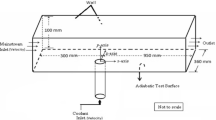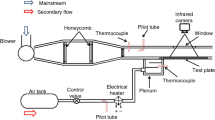Abstract
The cooling performance of combined cooling depends on the cooling performance of individual structures, such as film cooling and impingement cooling, and the interaction between the two structures. This paper uses a numerical simulation method to thoroughly study a flat plate model with a combined cooling structure of impingement/film cooling, employing the Shear Stress Transport (SST) turbulence model. The aim is to reveal the impact of different impingement and film structures on the overall cooling effectiveness, providing theoretical guidance for engineering applications. At a typical blowing ratio of 1.5, various impingement cooling structures with different hole diameters, impingement distances, and hole shapes are considered, combined with two types of outer film cooling holes (simple cylindrical and cratered holes). The results indicate that the three variations in the internal cooling structure positively impact the internal heat transfer coefficient and the overall cooling effectiveness on the outer wall. Among them, the influence of the hole diameter factor is the most significant, while the impact of the impingement distance is less pronounced. Benefiting from the anti-kidney vortex pairs of the cratered film cooling holes, the cratered 2 improves the area-averaged overall cooling effectiveness by 38.69% compared with the simple cylindrical reference film cooling hole. Within the blowing ratio range of 0.5–2.5, using cratered 2 and the optimal impingement cooling structure, the overall cooling effectiveness is improved by 20.39–39.14% compared with the standard impingement structure and cylindrical film cooling hole combined structure.



















Similar content being viewed by others
References
Tyagi M, Acharya S (2003) Large eddy simulation of film cooling flow from an inclined cylindrical jet. ASME J Turbomach 125:734–742. https://doi.org/10.1115/1.1625397
Goldstein RJ, Eckert ER, Burggraf F (1974) Effects of hole geometry and density on three-dimensional film cooling. Int J Heat Mass Transfer 17:595–607. https://doi.org/10.1016/0017-9310(74)90007-6
Bunker RS (2005) A review of shaped hole turbine film cooling technology. ASME J Heat Mass Transfer 127:441–453. https://doi.org/10.1115/1.1860562
Dai P, Lin F (2011) Numerical study on film cooling effectiveness from shaped and crescent holes. Heat Mass Transfer 47:147–154. https://doi.org/10.1007/s00231-010-0692-5
Lee KD, Kim KY (2012) Performance evaluation of a novel film-cooling hole. ASME J Heat Mass Transfer 134:101702. https://doi.org/10.1115/1.4006752
Kusterer K, Tekin N, Reiners F, Bohn D, Sugimoto T, Tanaka R, Kazari M (2013) Highest-efficient film cooling by improved nekomimi film cooling holes: Part 1—ambient air flow conditions. In: Turbo Expo: Power for Land, Sea, and Air (Vol. 55157, p. V03BT13A040). American Society of Mechanical Engineers.https://doi.org/10.1115/GT2013-95027
Zhu R, Zhang GH, Li SL, Xie GN (2021) Combined-hole film cooling designs based on the construction of antikidney vortex structure: a review. ASME J Heat Mass Transfer 143:030801. https://doi.org/10.1115/1.4048948
Bunker RS (2002) Film cooling effectiveness due to discrete holes within a transverse surface slot. In: Proc. ASME Turbo Expo, pp. GT2002–30178. https://doi.org/10.1115/GT2002-30178
Krishna Anand VG, Parammasivam KM (2021) Thermal barrier coated surface modifications for gas turbine film cooling: a review. J Therm Anal Calorim 146:545–580. https://doi.org/10.1007/s10973-020-10032-2
Dorrington JR, Bogard DG, Bunker RS (2007) Film effectiveness performance for coolant holes embedded in various shallow trench and crater depressions. In: Proc. ASME Turbo Expo, pp. GT2007–27992. https://doi.org/10.1115/GT2007-27992
Tran N, Nguyen C, Ho S, Kapat J (2010) Prediction of adiabatic effectiveness of various cratered film hole configurations: Sensitivity analysis for the rectangle shaped mask. In: Proc. 48th AIAA, pp. AIAA 2010–404. https://doi.org/10.2514/6.2010-404
Lu Y, Dhungel A, Ekkad SV, Bunker RS (2009) Film cooling measurements for cratered cylindrical inclined holes. ASME J Turbomach 131:011005. https://doi.org/10.1115/1.2950055
Khalatov A, Panchenko NA, Severin SD (2017) Application of cylindrical, triangular, and hemispherical dimples in the film cooling technology. J Phys: Conf Ser 891:012145. https://doi.org/10.1088/1742-6596/891/1/012145
Khalatov A, Shi-Ju E, Wang D, Borisov I (2020) Film cooling evaluation of a single array of triangular craters. Int J Heat Mass Transf 159:120055. https://doi.org/10.1016/j.ijheatmasstransfer.2020.120055
Kalghatgi P, Acharya S (2015) Improved film cooling effectiveness with a round film cooling hole embedded in contoured crater. ASME J Turbomach 137:101006. https://doi.org/10.1115/1.4030395
Kalghatgi P, Acharya S (2019) Flow dynamics of a film cooling jet issued from a round hole embedded in contoured crater. ASME J Turbomach 141:081006. https://doi.org/10.1115/1.4043071
Zhang ZH, He K, Yan X (2020) Study on the cooling characteristics of flat plate air film with shaped cratered holes. J Xi’an Jiaotong Univ 54:84–93 ((In Chinese))
An BT, Liu JJ, Zhang XD, Zhou SJ, Zhang C (2016) Film cooling effectiveness measurements of a near-surface streamwise diffusion hole. Int J Heat Mass Transfer 159:1–13. https://doi.org/10.1016/j.ijheatmasstransfer.2016.07.028
Bai LC, Zhang C, (2019) Flow mechanism of cooling effectiveness improvement for the cylindrical film cooling hole with contoured craters, IOP Conf Ser: Mater Sci Eng, 473: 012033. https://doi.org/10.1088/1757-899X/473/1/012033
Fu JL, Bai LC, Zhang C, Ju PF (2019) Film cooling performance for cylindrical holes embedded in contoured craters: effect of the crater depth. J Appl Mech Tech Phys 60:1068–1076
Bai LC, Zhang C, Tong ZT, Ju PF (2021) Optimization of geometric parameters of cylindrical film cooling hole with contoured craters to enhance film-cooling effectiveness. Thermophys Aeromech 28:835–848. https://doi.org/10.1134/S0869864321060081
Zhang C, Wang WZ, Wang Z, Tong ZT (2022) Conjugate heat transfer simulation of overall cooling performance for cratered film cooling holes. Machines 10:395. https://doi.org/10.3390/machines10050395
Jiang Y, Capone L, Ireland P, Romero E (2018) A detailed study of the interaction between two rows of cooling holes. ASME J Turbomach 140:041008. https://doi.org/10.1115/1.4038833
Jindal P, Roy AK, Sharma RP (2016) Effect of hole shapes, orientation and hole arrangements on film cooling effectiveness. Int J Aeronaut Space Sci 17:341–435. https://doi.org/10.5139/IJASS.2016.17.3.341
Jindal P, Agarwal S, Sharma RP, Roy AK (2017) Numerical investigation of film cooling enhancement using staggered row mixed hole arrangements. J Therm Sci Eng Appl 9:021007. https://doi.org/10.1115/1.4035448
Jindal P, Agarwal S, Sharma RP, Roy AK (2018) Enhancement of film cooling effectiveness using rectangular winglet pair. J Therm Sci Eng Appl 10(041014):10. https://doi.org/10.1115/1.4039700
Anderson WS et al (2010) Effects of a reacting cross-stream on turbine film cooling. J. Eng. for Gas Turbines and Power 132:051501. https://doi.org/10.1115/1.3204616
Goodro M, Ligrani P, Fox M, Moon HK (2010) Mach number, Reynolds number, jet spacing variations: full array of impingement jets. J Thermophys Heat Transfer 24:133–144. https://doi.org/10.2514/1.44029
Haider SA, Yan XT (2016). Jet diameter effect on impingement jet cooling on the leading edge of a turbine blade. In: 54th AIAA Aerospace Sciences Meeting (p. 0905).https://doi.org/10.2514/6.2016-0905
Jordan CN, Elston CA, Wright LM, Crites DC (2013) Leading edge impingement with racetrack-shaped jets and varying inlet supply conditions. In: Proc. ASME Turbo Expo, pp. GT2013–94611. https://doi.org/10.1115/GT2013-94611
Ekkad SV, Singh PA (2021) A modern review on jet impingement heat transfer methods. ASME J Heat Mass Transfer 143:064001. https://doi.org/10.1115/1.4049496
Dutta S, Singh P (2021) Opportunities in jet-impingement cooling for gas turbine engines. Energies 14:6587. https://doi.org/10.3390/en14206587
Panda PK, Prasad BV (2012) Conjugate heat transfer from a flat plate with combined impingement and film cooling. In: Proc. ASME Turbo Expo, pp. GT2012–68830. https://doi.org/10.1115/GT2012-68830
Mensch A, Thole KA (2014) Overall effectiveness of a blade endwall with jet impingement and film cooling. ASME J Eng Gas Turbines Power 136:031901. https://doi.org/10.1115/1.4025835
Taslim ME, Pan Y, Spring SD (2001) An experimental study of impingement on roughened airfoil leading-edge walls with film holes. ASME J Turbomach 123:766–773. https://doi.org/10.1115/1.1401035
Nathan ML, Dyson TE, Bogard DG, Bradshaw SD (2014) Adiabatic and overall effectiveness for the showerhead film cooling of a turbine vane. ASME J Turbomach 136:031005. https://doi.org/10.1115/1.4024680
Jung EY, Chung H, Choi SM, Woo T, Cho HH (2017) Conjugate heat transfer on full-coverage film cooling with array jet impingements with various Biot numbers. Exp Therm Fluid Sci 83:1–8. https://doi.org/10.1016/j.expthermflusci.2016.12.008
Zhang P (2015) Gas film cooling and compound cooling gas-thermal coupling research. Master Thesis, Beijing: Graduate School of Chinese Academy of Sciences (Institute of Engineering Thermophysics).
Fu JL, Cao Y, Zhang C, Zhu JQ (2020) Investigation of the conjugate heat transfer and flow field for a flat plate with combined film and impingement cooling. J Therm Sci 29:955–971. https://doi.org/10.1007/s11630-020-1233-2
Liu RZ, Li HW, You RQ, Tao Z, Huang Y (2023) Numerical decoupling of the effect of internal cooling and external film cooling on overall cooling effectiveness. Appl Therm Eng 222:119905. https://doi.org/10.1016/j.applthermaleng.2022.119905
Wang WZ (2023) Investigation on conjugate heat transfer characteristics of the cratered film-cooling hole and impingement combined cooling structure, Master Thesis, Tianjin: Tianjin University of Technology.
Acknowledgements
This paper was funded by the National Natural Science Foundation of China (51976139).
Funding
National Natural Science Foundation of China, 51976139, Chao Zhang
Author information
Authors and Affiliations
Corresponding author
Ethics declarations
Conflict of interest
The authors declare no potential conflicts of interest concerning this article's research, authorship, and publication.
Additional information
Technical Editor: Guilherme Ribeiro.
Publisher's Note
Springer Nature remains neutral with regard to jurisdictional claims in published maps and institutional affiliations.
Rights and permissions
Springer Nature or its licensor (e.g. a society or other partner) holds exclusive rights to this article under a publishing agreement with the author(s) or other rightsholder(s); author self-archiving of the accepted manuscript version of this article is solely governed by the terms of such publishing agreement and applicable law.
About this article
Cite this article
Shen, Y., Wang, W., Zhang, M. et al. Effect of different internal impingement structures and cratered film cooling holes on overall cooling effectiveness. J Braz. Soc. Mech. Sci. Eng. 46, 300 (2024). https://doi.org/10.1007/s40430-024-04880-4
Received:
Accepted:
Published:
DOI: https://doi.org/10.1007/s40430-024-04880-4




